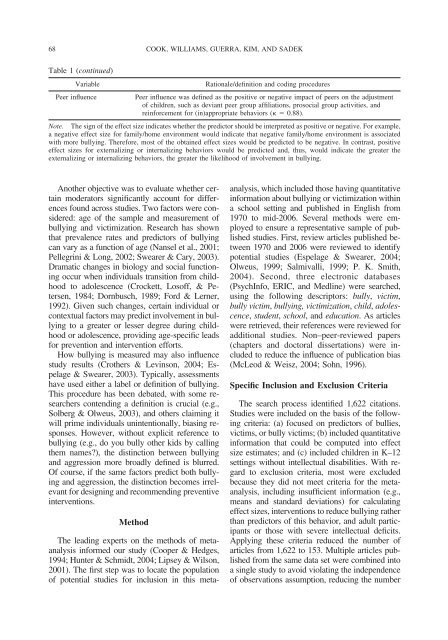Predictors of Bullying and Victimization in Childhood and Adolescence
Predictors of Bullying and Victimization in Childhood and Adolescence
Predictors of Bullying and Victimization in Childhood and Adolescence
You also want an ePaper? Increase the reach of your titles
YUMPU automatically turns print PDFs into web optimized ePapers that Google loves.
68 COOK, WILLIAMS, GUERRA, KIM, AND SADEK<br />
Table 1 (cont<strong>in</strong>ued)<br />
Variable Rationale/def<strong>in</strong>ition <strong>and</strong> cod<strong>in</strong>g procedures<br />
Peer <strong>in</strong>fluence Peer <strong>in</strong>fluence was def<strong>in</strong>ed as the positive or negative impact <strong>of</strong> peers on the adjustment<br />
<strong>of</strong> children, such as deviant peer group affiliations, prosocial group activities, <strong>and</strong><br />
re<strong>in</strong>forcement for (<strong>in</strong>)appropriate behaviors ( 0.88).<br />
Note. The sign <strong>of</strong> the effect size <strong>in</strong>dicates whether the predictor should be <strong>in</strong>terpreted as positive or negative. For example,<br />
a negative effect size for family/home environment would <strong>in</strong>dicate that negative family/home environment is associated<br />
with more bully<strong>in</strong>g. Therefore, most <strong>of</strong> the obta<strong>in</strong>ed effect sizes would be predicted to be negative. In contrast, positive<br />
effect sizes for externaliz<strong>in</strong>g or <strong>in</strong>ternaliz<strong>in</strong>g behaviors would be predicted <strong>and</strong>, thus, would <strong>in</strong>dicate the greater the<br />
externaliz<strong>in</strong>g or <strong>in</strong>ternaliz<strong>in</strong>g behaviors, the greater the likelihood <strong>of</strong> <strong>in</strong>volvement <strong>in</strong> bully<strong>in</strong>g.<br />
Another objective was to evaluate whether certa<strong>in</strong><br />
moderators significantly account for differences<br />
found across studies. Two factors were considered:<br />
age <strong>of</strong> the sample <strong>and</strong> measurement <strong>of</strong><br />
bully<strong>in</strong>g <strong>and</strong> victimization. Research has shown<br />
that prevalence rates <strong>and</strong> predictors <strong>of</strong> bully<strong>in</strong>g<br />
can vary as a function <strong>of</strong> age (Nansel et al., 2001;<br />
Pellegr<strong>in</strong>i & Long, 2002; Swearer & Cary, 2003).<br />
Dramatic changes <strong>in</strong> biology <strong>and</strong> social function<strong>in</strong>g<br />
occur when <strong>in</strong>dividuals transition from childhood<br />
to adolescence (Crockett, Los<strong>of</strong>f, & Petersen,<br />
1984; Dornbusch, 1989; Ford & Lerner,<br />
1992). Given such changes, certa<strong>in</strong> <strong>in</strong>dividual or<br />
contextual factors may predict <strong>in</strong>volvement <strong>in</strong> bully<strong>in</strong>g<br />
to a greater or lesser degree dur<strong>in</strong>g childhood<br />
or adolescence, provid<strong>in</strong>g age-specific leads<br />
for prevention <strong>and</strong> <strong>in</strong>tervention efforts.<br />
How bully<strong>in</strong>g is measured may also <strong>in</strong>fluence<br />
study results (Crothers & Lev<strong>in</strong>son, 2004; Espelage<br />
& Swearer, 2003). Typically, assessments<br />
have used either a label or def<strong>in</strong>ition <strong>of</strong> bully<strong>in</strong>g.<br />
This procedure has been debated, with some researchers<br />
contend<strong>in</strong>g a def<strong>in</strong>ition is crucial (e.g.,<br />
Solberg & Olweus, 2003), <strong>and</strong> others claim<strong>in</strong>g it<br />
will prime <strong>in</strong>dividuals un<strong>in</strong>tentionally, bias<strong>in</strong>g responses.<br />
However, without explicit reference to<br />
bully<strong>in</strong>g (e.g., do you bully other kids by call<strong>in</strong>g<br />
them names?), the dist<strong>in</strong>ction between bully<strong>in</strong>g<br />
<strong>and</strong> aggression more broadly def<strong>in</strong>ed is blurred.<br />
Of course, if the same factors predict both bully<strong>in</strong>g<br />
<strong>and</strong> aggression, the dist<strong>in</strong>ction becomes irrelevant<br />
for design<strong>in</strong>g <strong>and</strong> recommend<strong>in</strong>g preventive<br />
<strong>in</strong>terventions.<br />
Method<br />
The lead<strong>in</strong>g experts on the methods <strong>of</strong> metaanalysis<br />
<strong>in</strong>formed our study (Cooper & Hedges,<br />
1994; Hunter & Schmidt, 2004; Lipsey & Wilson,<br />
2001). The first step was to locate the population<br />
<strong>of</strong> potential studies for <strong>in</strong>clusion <strong>in</strong> this meta-<br />
analysis, which <strong>in</strong>cluded those hav<strong>in</strong>g quantitative<br />
<strong>in</strong>formation about bully<strong>in</strong>g or victimization with<strong>in</strong><br />
a school sett<strong>in</strong>g <strong>and</strong> published <strong>in</strong> English from<br />
1970 to mid-2006. Several methods were employed<br />
to ensure a representative sample <strong>of</strong> published<br />
studies. First, review articles published between<br />
1970 <strong>and</strong> 2006 were reviewed to identify<br />
potential studies (Espelage & Swearer, 2004;<br />
Olweus, 1999; Salmivalli, 1999; P. K. Smith,<br />
2004). Second, three electronic databases<br />
(PsychInfo, ERIC, <strong>and</strong> Medl<strong>in</strong>e) were searched,<br />
us<strong>in</strong>g the follow<strong>in</strong>g descriptors: bully, victim,<br />
bully victim, bully<strong>in</strong>g, victimization, child, adolescence,<br />
student, school, <strong>and</strong> education. As articles<br />
were retrieved, their references were reviewed for<br />
additional studies. Non–peer-reviewed papers<br />
(chapters <strong>and</strong> doctoral dissertations) were <strong>in</strong>cluded<br />
to reduce the <strong>in</strong>fluence <strong>of</strong> publication bias<br />
(McLeod & Weisz, 2004; Sohn, 1996).<br />
Specific Inclusion <strong>and</strong> Exclusion Criteria<br />
The search process identified 1,622 citations.<br />
Studies were <strong>in</strong>cluded on the basis <strong>of</strong> the follow<strong>in</strong>g<br />
criteria: (a) focused on predictors <strong>of</strong> bullies,<br />
victims, or bully victims; (b) <strong>in</strong>cluded quantitative<br />
<strong>in</strong>formation that could be computed <strong>in</strong>to effect<br />
size estimates; <strong>and</strong> (c) <strong>in</strong>cluded children <strong>in</strong> K–12<br />
sett<strong>in</strong>gs without <strong>in</strong>tellectual disabilities. With regard<br />
to exclusion criteria, most were excluded<br />
because they did not meet criteria for the metaanalysis,<br />
<strong>in</strong>clud<strong>in</strong>g <strong>in</strong>sufficient <strong>in</strong>formation (e.g.,<br />
means <strong>and</strong> st<strong>and</strong>ard deviations) for calculat<strong>in</strong>g<br />
effect sizes, <strong>in</strong>terventions to reduce bully<strong>in</strong>g rather<br />
than predictors <strong>of</strong> this behavior, <strong>and</strong> adult participants<br />
or those with severe <strong>in</strong>tellectual deficits.<br />
Apply<strong>in</strong>g these criteria reduced the number <strong>of</strong><br />
articles from 1,622 to 153. Multiple articles published<br />
from the same data set were comb<strong>in</strong>ed <strong>in</strong>to<br />
a s<strong>in</strong>gle study to avoid violat<strong>in</strong>g the <strong>in</strong>dependence<br />
<strong>of</strong> observations assumption, reduc<strong>in</strong>g the number
















